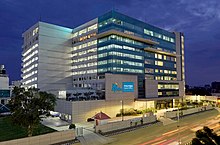
Back الرعاية الصحية في الهند Arabic भारत में स्वास्थ्य देखभाल HI インドの医療 Japanese 인도의 보건의료 Korean Healthcare in India SIMPLE บริการสุขภาพในประเทศอินเดีย Thai





India has a multi-payer universal health care model that is paid for by a combination of public and government regulated (through the Insurance Regulatory and Development Authority) private health insurances along with the element of almost entirely tax-funded public hospitals.[1] The public hospital system is essentially free for all Indian residents except for small, often symbolic co-payments in some services.[2] Economic Survey 2022-23 highlighted that the Central and State Governments’ budgeted expenditure on the health sector reached 2.1% of GDP in FY23 and 2.2% in FY22, against 1.6% in FY21.[3] India ranks 78th and has one of the lowest healthcare spending as a percent of GDP. It ranks 77th on the list of countries by total health expenditure per capita.
- ^ Zodpey, Sanjay; Farooqui, Habib Hasan (2018). "Universal Health Coverage in India: Progress achieved & the way forward". The Indian Journal of Medical Research. 147 (4): 327–329. doi:10.4103/ijmr.IJMR_616_18. PMC 6057252. PMID 29998865.
- ^ "India | Commonwealth Fund". 5 June 2020. Archived from the original on 24 December 2020. Retrieved 9 October 2020.
- ^ "Archived copy". Archived from the original on 2 March 2024. Retrieved 2 July 2024.
{{cite web}}: CS1 maint: archived copy as title (link)